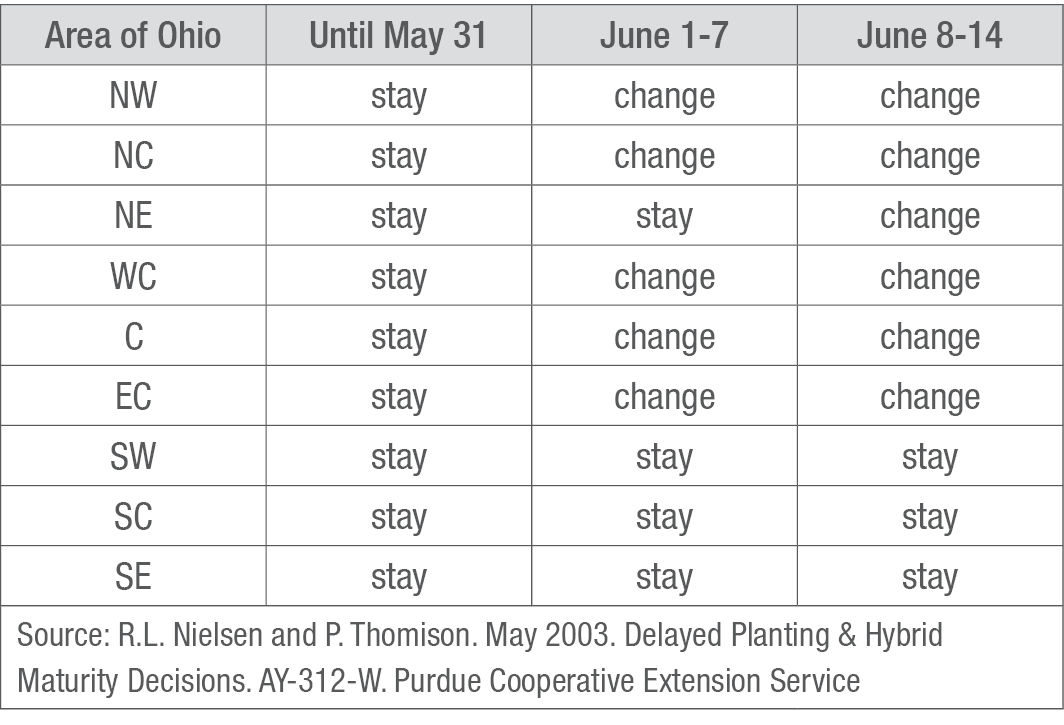Deciding When to Change to Earlier Relative Maturity (RM) Corn Products
June 17, 2024
When corn planting is delayed past the optimum time for the chosen relative maturity (RM), growers have to determine if changing to an earlier RM product can potentially provide a greater return on investment.
Understanding Growing Degree Day Units
Corn growth and development is determined by the accumulation of growing degree day (GDD) units. The minimum temperature for corn growth is 50 °F. Therefore, when the average temperature in a 24-hour period is above 50 °F, growth occurs and corn accumulates GDDs. A corn crop’s GDD accumulation can be calculated by determining the average temperature in degrees Fahrenheit for a 24-hour period and subtracting that average from 50. A grower can predict a corn crop’s development stage by adding the accumulated GDDs over a season. Depending on the specific product, corn requires approximately 1250 to 1360 GDDs to reach mid-pollination and 2550 to 2800 GDDs to reach physiological maturity or black layer. Corn tends to accumulate fewer GDDs at planting and early in the season compared to flowering and drydown later in the season when average temperatures are likely higher.
Changes in Growing Degree Day Unit Requirements
Corn products may mature in fewer GDDs than predicted if they are planted late. A study published in 2002 found corn products in the eastern Corn Belt required approximately 6.8 fewer GDDs to mature for every day their planting was delayed beyond May 1 through at least the second week of June (which were the latest planting dates evaluated in the study).1 For example, if a corn product with a rating of 2700 GDDs from planting to black layer is planted on June 1, it may reach black layer in less than 2500 GDDs (2,700 GDDs − (31 days delay x 6.8) = 2489.2 GDDs).
Should You Switch?
The USDA-NIFA funded the development of a corn growing degree day decision support tool which can be found here: https://hprcc.unl.edu/agroclimate/gdd.php. The Corn GDD Tool estimates county-level GDD accumulations and corn development dates based on current and historical GDD data. It allows the user to select start dates, relative corn product maturity ratings, GDDs to black layer, and freeze temperature threshold values. The estimates are displayed graphically and in a table, and the results can be downloaded in a comma separated value (.csv) formatted file for use in a spreadsheet program. The GDD Tool is currently available for Illinois, Indiana, Iowa, Kansas, Kentucky, Michigan, Minnesota, Missouri, Nebraska, North Dakota, Ohio, South Dakota, Tennessee, and Wisconsin. There is also a new GDD tool called CliGrow (https://hprcc.unl.edu/agroclimate/gdd.php) that can be used nationwide for corn and other crops. These tools can be used to determine the time needed for a given corn product to reach maturity.
If a grower’s main concern is to identify a "safe" corn product that can reach physiological maturity before a typical fall freeze date, then using the above tools and calculations can help accomplish that. Some growers may opt to select an "end of season" date earlier than the historical first fall freeze date to help ensure that physiological maturity occurs earlier to potentially allow for some grain drydown in the field. Field drying can help minimize the expense of drying the grain artificially.
Keep in mind that the above tools do NOT take into account that corn products may mature with fewer GDDs than expected when planted after May 1. The tool assumes the same GDD to black layer regardless of planting date. Therefore, growers must manually change the expected black layer GDD to the appropriate value to obtain more realistic estimates.

Other Factors
- When deciding whether to change corn products, it is important to consider other agronomic traits of the proposed new product beyond just the RM, such as its disease resistance and drought stress. This is especially important if switching products in a late-planting scenario.
- Currently, there is no clear data on the potential yield differences between late-planted full- and short-season corn products. As such, growers may wish to focus on whether a particular product can reach black layer when planted late and if grain moisture differences at harvest should be considered.
- Seeding rate should not be changed if planting late.2
Sources
1Nielsen, R.L., Thomison, P.R., Brown, G.A., Halter, A.L., Wells, J., and Wuethrich, K.L. 2002. Delayed planting effects on flowering and grain maturation of dent corn. Agronomy. Journal. 94: 549–558. https://doi.org/10.2134/agronj2002.5490
2Nielsen, R.L. 2019. Optimum plant populations for delayed planting of corn. Purdue University, Corny News Network. https://www.agry.purdue.edu/ext/corn/news/timeless/CornPltPopPltDate.html
Additional Resources
Nielsen, R.L. 2022. Hybrid maturity decisions for delayed planting. Purdue University, Corny News Network. https://www.agry.purdue.edu/ext/corn/news/timeless/HybridMaturityDelayedPlant.html
Web sources verified 06/10/24.
1210_421286